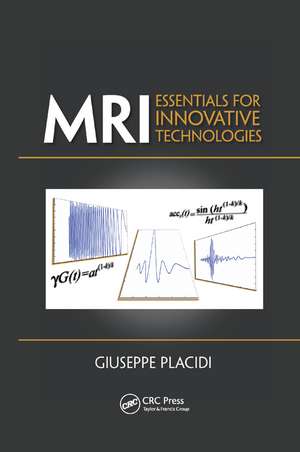MRI: Essentials for Innovative Technologies
Autor Giuseppe Placidien Limba Engleză Paperback – 21 oct 2019
After a concise review of basic mathematical tools and the physics of MRI, the book describes the severe artifacts produced by conventional MRI techniques. It first tackles magnetic field inhomogeneities, outlining conventional solutions as well as a completely different approach based on time-varying gradients and temporal frequency variation coding (acceleration). The book then proposes two innovative acquisition methods for reducing acquisition time, motion, and undersampling artifacts: adaptive acquisition and compressed sensing. The concluding chapter lays out the author’s predictions for the future of MRI.
For some of the proposed solutions, this is the first time the reported results have been published. Where experimental data is preliminary or unavailable, the book presents only numerical solutions. Offering insight into emerging MRI techniques, this book provides readers with specialized knowledge to help them design better acquisition sequences and select appropriate correction methods.
The author’s proceeds from the sale of this book will be entirely donated to Bambin Gesù Children’s Hospital in Rome.
Preț: 369.50 lei
Preț vechi: 476.78 lei
-23% Nou
Puncte Express: 554
Preț estimativ în valută:
70.70€ • 74.02$ • 58.50£
70.70€ • 74.02$ • 58.50£
Carte tipărită la comandă
Livrare economică 07-21 aprilie
Preluare comenzi: 021 569.72.76
Specificații
ISBN-13: 9780367381431
ISBN-10: 0367381435
Pagini: 216
Ilustrații: 85
Dimensiuni: 156 x 234 mm
Greutate: 0.41 kg
Ediția:1
Editura: CRC Press
Colecția CRC Press
ISBN-10: 0367381435
Pagini: 216
Ilustrații: 85
Dimensiuni: 156 x 234 mm
Greutate: 0.41 kg
Ediția:1
Editura: CRC Press
Colecția CRC Press
Public țintă
Academic and Professional Practice & DevelopmentCuprins
Basic Concepts: Mathematical Tools. MRI: Conventional Imaging Techniques and Instruments. Limitations of Conventional MRI: Limiting Artifacts for Advanced Applications. Advanced Solutions: Methods for Magnetic Field Inhomogeneity Reduction. Methods to Handle Undersampling. The Future: Conclusions and perspectives. Bibliography. Index.
Notă biografică
Giuseppe Placidi is an assistant professor in Computer Science in the Department of Health Sciences at the University of L’Aquila. He has authored or co-authored more than 55 papers published in international scientific journals and books, 60 refereed conferences proceedings, and seven patents. He is a member of the IEEE Engineering in Medicine and Biology Society, the IEEE Computer Society, the Italian Group for Electron Spin Resonance (GIRSE), and the Italian Group for Physics of Matter (INFM). Dr. Placidi is also a reviewer for several scientific journals on medical physics and imaging. His research interests include MRI, MRI acquisition sequences, image reconstruction, image analysis, image compression, and information theory.
For more information, see www.giuseppeplacidi.org.
For more information, see www.giuseppeplacidi.org.
Recenzii
"MRI Essentials for Innovative Technologies describes novel methods to improve MRI beyond its current limitations and combines rigorous development of mathematical concepts with descriptive presentations of the emerging MRI techniques. …Although this book covers a specialized area of MRI and the emerging technologies around this imaging modality, the text is comprehensible to most readers."
—IEEE Pulse Magazine, April 2014
"The deep physical insight into the relationship between spin dynamics and gradient field modulation expressed in this book paves the way to a completely new family of pulse sequences that may represent a new line of development for MRI. As a whole, this excellent book should be found on the bookshelves of all those specializing in the field of magnetic resonance."
—From the Foreword by Antonello Sotgiu, Professor and Chairman, Department of Health Sciences, University of L'Aquila, Italy
"[This book] is complete, readable and usable both for research and for specialized learning purposes in areas of advanced MRI imaging techniques. Dr. Placidi indicates a path useful to both physicists and engineers for implementation, and to radiologists and clinicians in thinking of possible new ways to apply the suggested methods."
—From the Foreword by Roberto Passariello, MD, Professor and Chairman, Department of Radiological Sciences, Policlinico Umberto I, Sapienza University of Rome, Italy
—IEEE Pulse Magazine, April 2014
"The deep physical insight into the relationship between spin dynamics and gradient field modulation expressed in this book paves the way to a completely new family of pulse sequences that may represent a new line of development for MRI. As a whole, this excellent book should be found on the bookshelves of all those specializing in the field of magnetic resonance."
—From the Foreword by Antonello Sotgiu, Professor and Chairman, Department of Health Sciences, University of L'Aquila, Italy
"[This book] is complete, readable and usable both for research and for specialized learning purposes in areas of advanced MRI imaging techniques. Dr. Placidi indicates a path useful to both physicists and engineers for implementation, and to radiologists and clinicians in thinking of possible new ways to apply the suggested methods."
—From the Foreword by Roberto Passariello, MD, Professor and Chairman, Department of Radiological Sciences, Policlinico Umberto I, Sapienza University of Rome, Italy
Descriere
This book describes innovative methods to improve magnetic resonance imaging (MRI) beyond its current limitations. The author proposes smart encoding methods and acquisition sequences to deal with frequency displacement due to residual static magnetic field inhomogeneity, motion, and undersampling. After a concise review of basic mathematical tools and the physics of MRI, the book describes each limitation and then proposes solutions for overcoming it. Requiring few or no hardware modifications, these speculative methods represent building blocks for more advanced MRI applications. The book also looks to the future of MRI.
